
.
Directors: Zack Snyder, Joss Whedon (uncredited)
By Roderick Heath
Here we go again.
Zack Snyder’s films for the DC Comics-Warner Bros. imprimatur have provided ready whipping boys on the contemporary pop culture scene. Compared to Marvel-Disney’s current stranglehold on the zeitgeist, with their chintzy, jolly, near-indistinguishable entries, Snyder’s films, cloaked in a dusky, gothic stature, have aimed higher. I was never particularly sold on Christopher Nolan’s laboriously pseudo-realist Batman films, but I found Man of Steel (2013) a truly ambitious attempt on Snyder’s part to render DC’s superhero roster distinct from its rivals by viewing it through lenses of both neo-mythology and the post-Alan Moore style of introspective, self-critiquing comic book saga. His Superman questioned his own right to do what he does before finally being obliged to shatter a city to save the world. Such conceits were true to the themes of DC’s attempts to deepen its lexicon and complicate the world-view of their superhero comics since the late-1980s, but many critics and viewers responded as if their understanding of the mode hadn’t changed since the 1960s Batman TV series.
.
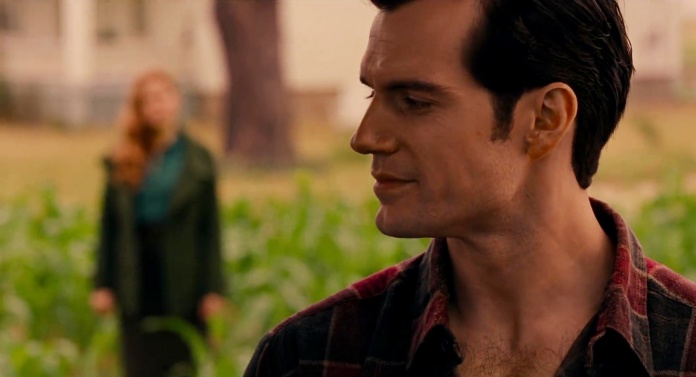
.
When I first saw Snyder’s follow-up, Batman v. Superman: Dawn of Justice (2016), I found it a ragged, intermittently impressive mess. Revisiting Snyder’s director’s cut of the film, I saw the themes and style had been rendered truly epic, interweaving real-world contexts – fears of terrorism, the fallout of war, the tattering of social and civic institutions in the face of the 21st century’s atomising realities – with familiar but refreshed generic concerns and some irretrievably lumpy franchise development. All this was achieved through Snyder’s patented visual muscle, granted a stately gravitas that stands a good chance of being remembered not as the worst moment of the superhero craze, as many declared it, but the finest. Patty Jenkins’ Wonder Woman earlier this year won popular plaudits for retaining a fair mimicry of Snyder’s style whilst cutting out the complexity of theme and vision and offering a straight-up new-age heroine. And David Ayer’s Suicide Squad…well, that was just crap.
.
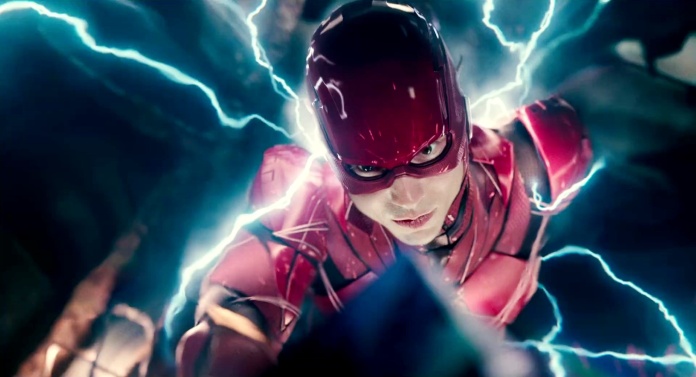
.
Justice League, Snyder’s latest offering, is the official moment of consummation when the DC-Warner brand arrives at its The Avengers (2012) moment in teaming up its flagship heroes. Supposedly, following Dawn of Justice’s oft-withering critical reception, it was hastily redrawn, and Snyder’s withdrawal during post-production because of a family tragedy saw The Avengers helmsman Joss Whedon, who is also credited as co-screenwriter with Chris Terrio, brought in to oversee reshoots and inject more of his trademark blend of gags and geekery. There is good reason to be nervous about such shifts in vision. Snyder’s Sucker Punch (2011) and Dawn of Justice were both badly hurt by studio-mandated snipping only to be revealed more truly in their extended editions. Justice League also has its share of heavy lifting to do. Although these specific takes on Clark ‘Superman’ Kent (Henry Cavill), Bruce ‘Batman’ Wayne (Ben Affleck), and Diana ‘Wonder Woman’ Prince (Gal Gadot) now have been thoroughly introduced to audiences, we also now have along for the ride Arthur ‘Aquaman’ Curry (Jason Momoa), Barry ‘The Flash’ Allen (Ezra Miller), and Victor ‘Cyborg’ Stone (Ray Fisher). These newcomers were briefly glimpsed in Dawn of Justice as a gallery of ‘metahumans’ Lex Luthor (Jesse Eisenberg) was tracking, with the potential to create a potential line-up of heroic defenders to fill the extremely large gap left by the death of Superman.
.

.
The start of Justice League takes up where that film left off, with its landscape of ruination and setback both physical and moral: in an opening that tips a self-evident nod to Snyder’s equally iconographic opening for his take on Moore’s Watchmen (2009), he sets Sigrid’s cover version of Leonard Cohen’s cynical anthem “Everybody Knows” to visions of resurging patterns of crime and anxiety following the fall of the Kryptonian hero. Renewing his nocturnal adventures in Gotham City, Bruce encounters a grotesque, flying alien creature which he attracts by dangling a hapless criminal from a rooftop as bait. Diana returns to crime fighting, saving hostages from a gang of nihilist terrorists who want to restore “holy terror” as a state of being for humanity in the face of titanic universal forces. Lois Lane (Amy Adams) has retreated into a bubble of soft news stories whilst trying to work through her grief following Clark’s passing. His mother Martha (Diane Lane) loses the family farm to the bank. Believing the alien to be a scout for an oncoming assault by a powerful host, Bruce and Diana set out to track down the other metahumans. Soon that host arrives, flocking at the behest of interdimensional fiend Steppenwolf (Ciaran Hinds), who in aeons past almost conquered and laid waste to the Earth in his attempts to bring together three “mother boxes” that when pieced together fuse into a terraforming device of unbelievable power. A great alliance of ancient races and alien ‘gods’ defeated Steppenwolf’s armies and drove him into exile, but now with Earth absent its great defender, Steppenwolf attacks the Amazon capital Themiscyra where the first box is held, battling Queen Hippolyta (Connie Nielsen) and her hordes of sword-wielding equestriennes.
.
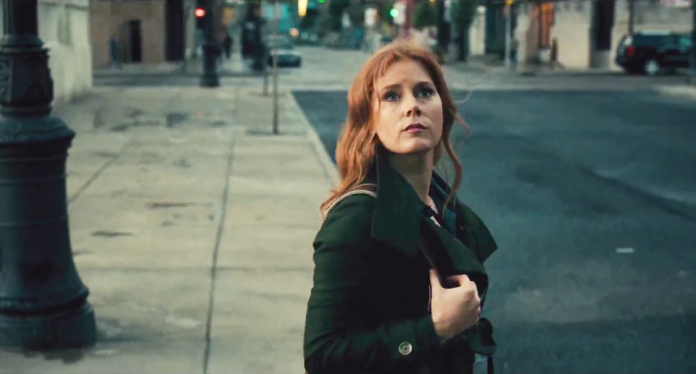
.
Meanwhile our earthly heroes attempt to fuse into a coherently operating unit. Barry, having been blessed with astonishing speed thanks to a freakish incident involving lightning, is a waggish but neurotic outsider living off the grid and fuelled by needy angst concerning his imprisoned father (Billy Crudup). Arthur is the heir to the sunken kingdom of Atlantis, but rather than hang out with his fellows like Mera (Amber Heard), who watches over the second mother box, Arthur prefers to spend his days wandering the seas, lending a hand to folks in need like a penurious Icelandic village and a sinking trawler crew. Victor is the newest and most troubled candidate for superhero status. He’s the son of a scientist, Silas Stone (Joe Morton), who was investigating the third mother box, retrieved by perplexed archaeologists. Following his son’s terrible injuries in a car crash, Silas tried to rebuild his boy with the box, only to result in a strange, constantly evolving and upgrading fusion of man and machine. Victor hides out in his father’s apartment, fretting over his changing nature and battling the alien influence he constantly senses attempting to subsume his identity and control over the new form he’s taken. He has the ability to connect with other technologies and parse information at incredible speeds, and he detects Bruce and Diana’s attempts to track him down even before they properly start. Diana, who’s attempting to come out of her self-imposed isolation after the death of her lover Steve Trevor in World War I, appeals to Victor to do the same. But when they go up against Steppenwolf and his minions for the first time, the team realises quickly and forlornly that they don’t stand much of a chance without Superman.
.
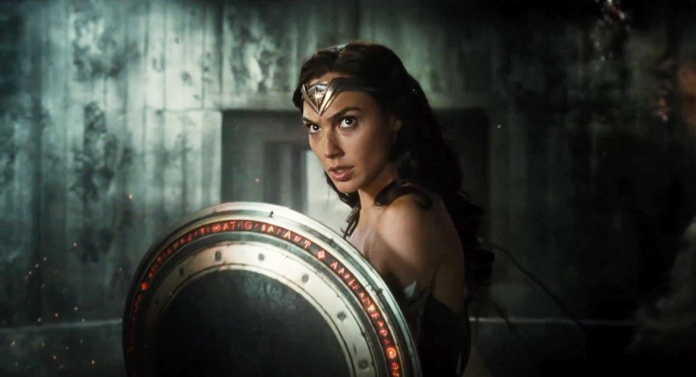
.
Justice League arrives on the big screen with a heavy air of compromise hovering about it. Often it betrays an initial intention to follow on from Dawn of Justice’s weighty reckonings, and add up to a mythic-scale song of rebirth to counter the previous film’s death trip. This aspect is borne out not merely by Superman’s eventual resurrection but by a climax that pays off in the perversely beautiful sight of alien flowers blooming amidst devastation, capping the motifs of revival and synthesis. Early sequences including Diana’s intervention in the terrorist attack and Steppenwolf attacking Themiscyra prove Snyder’s chops for this sort of thing are almost unequalled in current film, striking momentously heroic notes Wonder Woman laboured for two hours to sound properly. The second sequence is a particularly giddy and momentous interlude, as the cosmic monstrosity beams into an Amazonian temple stronghold to retrieve the mother box, complete with hammer-swinging muscular giantesses bringing down the roof and a desperate relay race trying to keep the box out of the villain’s hands, culminating in a colossal Amazon cavalry charge. It’s a pity the whole film can’t sustain such elephantine, madcap absurdity.
.

.
Much as he threatened to do often on 300 (2006), Snyder shifts into full-bore Peter Jackson-does-Tolkien territory for a flashback to the ancient war to defeat Steppenwolf, a gloriously weird spectacle of Amazons, Atlanteans, deities, and even a Green Lantern getting stuck into a colossal brawl. I got the feeling this scene, interpolated halfway through the film, was initially intended as an epic prologue like the Krypton scenes in Man of Steel. Instead it’s reduced to mind-numbingly expensive exposition. The epic film originally intended has been chopped up and interspersed with another one, Whedon’s more traditional matinee romp draped over the mythopoeic design. This is not necessarily a terrible thing, although I would’ve preferred to watch Snyder’s original concept. The relative ease with which the film incorporates the Flash, Cyborg, and Aquaman, on the other hand, raises the question as to whether all those long, involved stand-alone introductions were necessary, as we go down the Seven Samurai (1954) route of meeting new heroes with individual talents and angsts noted in quick thumbnails of biography and characterisation. Flourishes of Whedon’s trademark stammering yet wordy humour, most of it wielded by gawky and entertaining Miller, actually work in the same way as those sprouting flowers, little squiggles of colour decorating a moody landscape. And yet it also leaves the film creaking in uneasy switchbacks of dramatic style and affect.
.
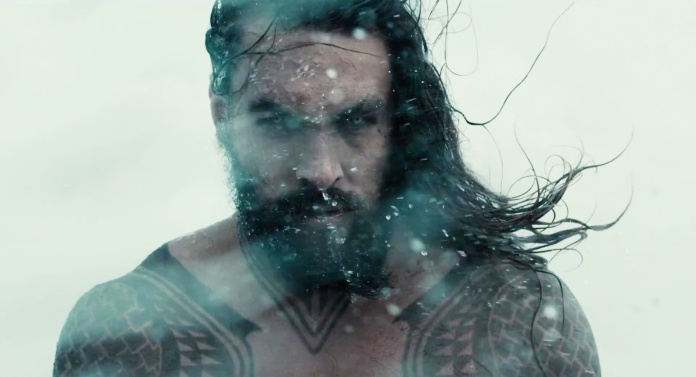
.
Snyder is anything but a subtle filmmaker, but he has two qualities that constantly arrest me. First, and most self-evidently, he’s a director who is properly and entirely visual. His images maintain connection with a bygone age in cinema, the time of Fritz Lang, Michael Curtiz, Cecil B. DeMille, F.W. Murnau, and other masters of film seen as an atavistic art of unchained spectacle. In an age in which cinema too often feels squeezed, cropped, and otherwise denuded by eyes too used to other platforms, he wants his pictures to sweep up the viewer like a physical force. Even in some throwaway sequences in Justice League, like a moment when Aquaman strides out onto a groin to let storm waves crash upon him, Snyder offers pictures of acromegaliac beauty. Snyder wants the audience to see every particle of water and feel its gush and enjoy the noble boner provoked by such manly spectacle. Secondly, he’s developed a surprisingly rigorous chain of motifs in his work. Even 300, the digitally-rendered peplum that made Snyder a Hollywood heavy-hitter and became a dudebro keepsake, was a work compelled by the disparity between the roots of heroic myth and the act of transmitting it, retelling the legend of Thermopylae in a manner its participants would have understood, a duel of propaganda in outsized nobility and debased and deformed opposition. Watchmen set the infrastructure of the comic book universe at war with itself. Sucker Punch portrayed the ecstatic release of fantasising colliding hard with bleak realities. Man of Steel and Dawn of Justice mediated his critical impulses amidst the borrowed finery of a commonly beloved cosmology.
.
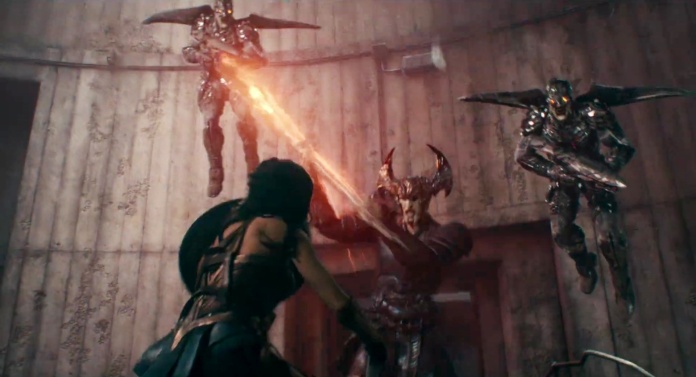
.
I keep wondering what film scholars might make of the popularity of superhero tales in the second decade of the 21st century in a few decades’ time. So resolute is the mode’s grip on the current box office that it will certainly seem a prognosticative aspect of the age, like the popularity of westerns and religious epics in the 1950s or spy films in the 1960s. It’s certainly not that hard to discern the reasons for their popularity. The genre – I feel it’s safe to call it a genre now – places specific individuals at the centre of modern special effects techniques, and on the dramatic level they work the same way, enacting and complicating basic fantasies of empowerment. It seems the basic matter of whether or not these individual films in this style work revolves around the degree to which they satisfy the schism between the desire to render them dramatically coherent and serious enough to sustain their own weight, and acknowledge their ridiculousness. The Marvel brand has maintained an unbroken run of success through easily and confidently varying a basic formula: a few laughs, a few thrills, a few feels. It’s both reliable and the exact opposite of any kind of creative risk, even the sort exhibited within the imposed limitations of genre and blockbuster intent. Even the superior examples of their approach, like Captain America: Civil War (2016) and Thor: Ragnarok (2017), only merely exemplify rather than enlarge their formula. Attempts to paint the superhero craze as some adjunct of a neo-fascist spirit have an accurate facet but also tend to get belaboured, in large part because they also fail to read their essential subject as being the ambivalent relationship between the individual and the community.
.
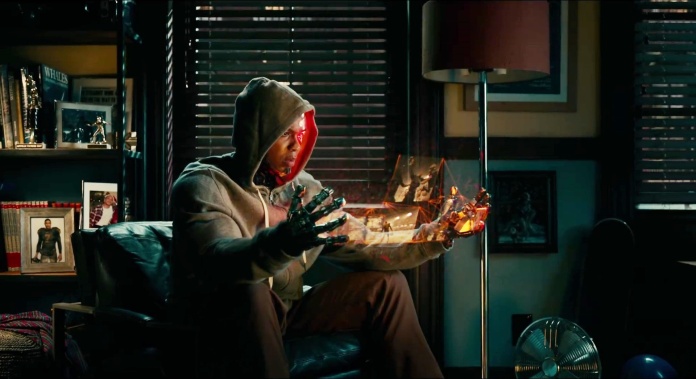
.
I seem to prefer this branch of the superhero craze in part because of this sort of thing, as it exists in the same context as any other genre, one where bad things happen that mostly can’t be undone and the distanced metaphors mean something. If superhero movies are the westerns of today, call these the John Ford and Anthony Mann westerns to counterbalance Marvel’s pleasant servicing of The Lone Ranger crowd. I know that’s a blasphemous way of framing this phenomenon for many, perhaps even to me, and yet I can’t get away from it. For instance, most takes on Superman neglected his alien state before these films; Snyder put this aspect, and the question as to whether he can effectively defend a species who physical nature he does not share, at the centre of his take, a question that proved maniacally offensive to Bruce Wayne in Dawn of Justice, who proposed that only a weaker, mortal creature can be truly brave. Snyder and Terrio blurred the lines between Bruce and Lex Luthor’s motivations to a fascinating degree, suggesting the difference between their ultimate selves was one of personal struggle, one who emerged as Batman and another as supervillain. Bruce is back on an even keel in Justice League, purpose renewed by a sense of mission and also guttering guilt over his near-murder of his better self. He gets into a brief contretemps with Diana as he prods her over her prioritising her personal grief over her natural status as warrior leader, earning himself a wallop in the chest over mentioning Steve Trevor’s name in such a fashion. Similarly, the film’s glances over the shoulder at the travails of Lois and Martha keep the film rooted in the mood of bruised humanity that’s linked the entries in this cycle.
.
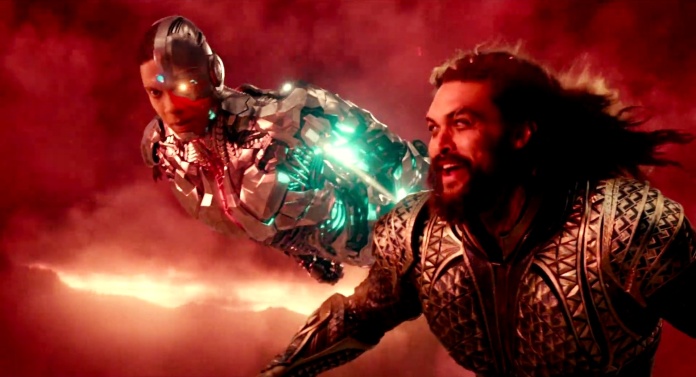
.
Victor’s struggle with his new, unpredictable, unnervingly self-willed cybernetic enhancements offers another stage for the running psychic struggle of man and superman. Victor’s lot as something not too far from the antihero of some body horror movie, glimpsed hiding in the shadows of his father’s apartment in a faintly menacing and baleful fashion that recalls Jeff Goldblum in David Cronenberg’s The Fly (1986), dealing with his rebelling body’s whims in randomly releasing dangerous energy blasts. Victor’s mainline into the technological marrow of the world swiftly proves indispensable, as he gains greater control over his “body” and joins his natural gifts for analysis to his augmented senses. Barry, on the other hand, in spite of his troubled past, provides uncomplicated dash and eccentric, boyish vigour to the enterprise. Aquaman arrives as perhaps the least well-developed of the characters in spite of possessing legendary backstory and having the oceans at his command. The film offers such brief visions of his underwater kingdom and fellow merpeople they scarcely register, and whilst the approach to Aquaman as a hairy, macho outsider, a bit of rough trade covered in tattoos, intends all too obviously to rescue the character from his previous status in the eyes many as a fey embarrassment in this realm, but instead too often symbolises the film’s awkward pandering in his swaggering faux-cool, such as his already immortally stilted exclamations of “My man” and “Booyah.”
.
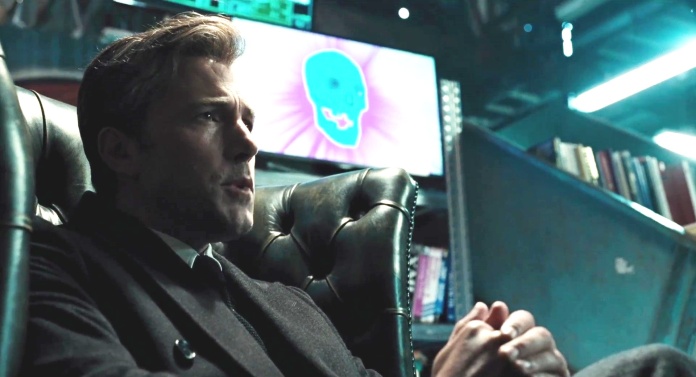
.
The film is also duty-bound to resurrect Superman, the figure whose presence haunts all the others, and this franchise in general. Superman’s fall and rise is one of those essential motifs, enacted in three of Christopher Reeve’s movies, and now taken to an extreme here, capping a trilogy that’s never been shy about evoking Superman’s status as messiah figure. Snyder’s visions of Clark in his cornfields retain a dusky romanticism as sentimental as anything Richard Donner purveyed in his classic film. Bruce concocts a method of resurrecting the singular hero by utilising the technology in the crashed Kryptonian spaceship still lying in downtown Metropolis and the power of the one mother box still in their hands. Successfully revived, Superman proves confused and aggressive, tossing his would-be helpmates around like skittles and threatening to crush Bruce between his bare hands. Bruce only forestalls his own messy demise by bringing out “the big gun,” which proves to be Lois; she successfully pacifies Clark and spirits him away to regain his bearings. Left with no choice but to venture into battle with Steppenwolf in his stronghold, the rest of the nascent league track the fiend to his base in an disused power plant somewhere in a former Soviet state, where he sets about uniting the talismanic boxes and unleashing its world-fashioning powers.
.
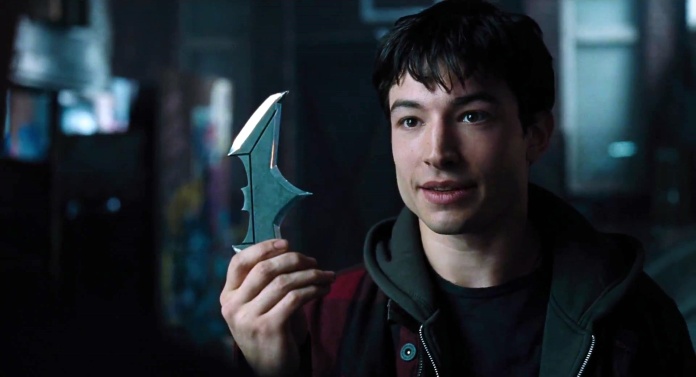
.
Whedon’s imprint on this material is apparent not just in the humour style and the quick fillips of characterisation, but also, more vexingly, in the resolute lack of cleverness in the storyline. We get elements of both his Avengers movies recycled wholesale, including a villain who beams in unexpectedly through a wormhole, and this kind of setting for the finale. Steppenwolf is a regulation comic book baddie, a big, weird, nasty alien with a demonic look whose motivations are never delved into beyond the obvious “he wants to destroy our world and build his own” sort of thing, who gets what he wants and then stands around waiting before doing what he intends just long enough for the heroes to turn up and stop him. Again, it’s not such a big crime to simply offer sufficient antagonism to spur the heroes, but it cuts against the grain of what this imprimatur has been striving to achieve. The only real topic The Avengers tackled was the proposition that a bunch of immensely talented screw-ups could unify and prove themselves an effective team, a theme with a certain level of self-reflexive import insofar as it clearly reflected the life of a Hollywood player like Whedon himself. And the essential theme of Justice League is…well, whether a bunch of immensely talented screw-ups can unify and prove themselves an effective team. Hell, DC already did that with Suicide Squad.
.
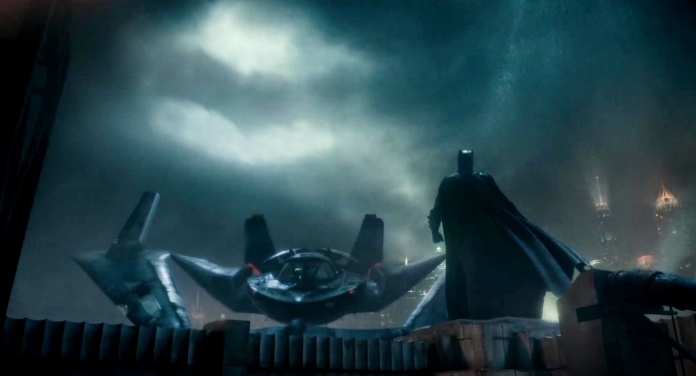
.
It’s this aspect of Justice League that left me frustrated even as I enjoyed the Irish stew it finally served up. Until now the Warner-DC cycle had tried, in however lumpy a fashion, to engage on committed dramatic level and translate comic book fare into a legitimate wing of cyberpunk-hued sci-fi. Justice League’s ultimate answer to the popular pressure upon the series delivers a fair crowd-pleaser but also jettisons the greater part of what made it interesting and distinctive. It pays off, but not with the heft Snyder’s labours to date deserved. There’s also been a noticeable shrinking of the horizons of this series since the truly epic opening scenes of Man of Steel, a film that was majestic on an audio-visual level. Now most of the fights seem to take place in sewers and industrial abodes, the finale drenched in ugly CGI patinas that look like the backdrops of computer games. The amazing thing about Justice League is that it doesn’t just hold together but somehow, in spite of everything compromised and cynical about it, it still manages to count for me as a kind of success, if only because it remains doggedly entertaining. Justice League certainly appeals to that perpetual six-year-old in the back of the mind who just thinks it’s rad to see Batman, Superman, and Wonder Woman kicking ass together. And those other guys too, why not.
.
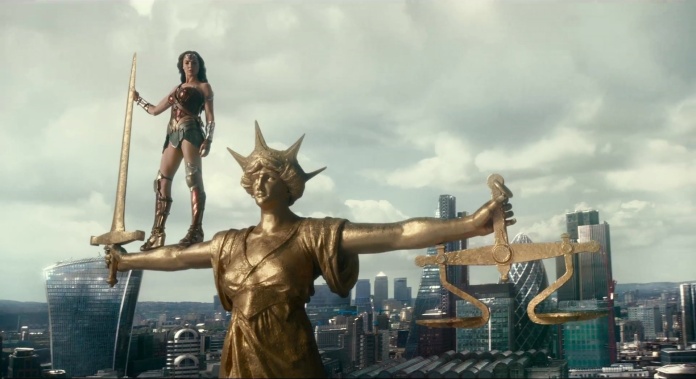
.
There’s at least one great joke at the expense of these superfriends, as Barry wheezes a proud gasp for breath after pushing a family out of the danger zone only to see Superman swing by with an entire apartment block on his shoulders. The glue that holds the enterprise together tend to be elements already been well-proven – Cavill’s disarmingly warm grin that lends supple charisma to his igneous frame, Gadot’s statuesque glamour charged with plucky, soulful intelligence. Affleck, who I found a surprisingly effective Caped Crusader in his first outing, seemed less sure to me here, however, particularly as he seems to have walked through some of the mandated reshoots: at least one of his line readings made me want someone to give him an adrenalin dose. Jeremy Irons (as Alfred) and J.K. Simmons (as Commissioner Gordon) were in there too, bewilderingly but gratifyingly. It also helps that Danny Elfman’s scoring is at least willing to service my kind of fan and toss in occasional flourishes of his old Batman (1989) theme and even a faint pastiche of John Williams’ mighty Superman fanfare, deployed at just the right moment, when the finale finally delivers the kind of righteous bash-up this entire cycle has been moving towards. I expect the film was always intended to be this kind of capstone to the cycle, and to get there, even in such an awkwardly framed result, still has a charge of fulfilment. And whilst I can’t say it knocked my socks off, I can’t say it was a few dollars badly spent, either. Perhaps, yet again, what this was supposed to be will eventually be seen on a smaller screen.

Great review again, Roderick. I’m an admirer of Zack Snyder (Sucker Punch, Watchmen, BvS, MoS) and see the critically abused film Rotten Tomatoes is unfortunate.
“Snyder is anything but a subtle filmmaker, but he has two qualities that constantly arrest me. First, and most self-evidently, he’s a director who is properly and entirely visual. His images maintain connection with a bygone age in cinema, the time of Fritz Lang, Michael Curtiz, Cecil B. DeMille, F.W. Murnau, and other masters of film seen as an atavistic art of unchained spectacle. ”
This is honest and courageous. The movie is better than I expected and Ezra Miller is Flash. Great design production!
Congratulations.
LikeLike
It’s an incredibly frustrating movie to critique due to the simple fact that what we’re seeing is so obviously a studio theatrical cut. Batman v Superman was 150 minutes on the big screen, and top-heavy as a result. Allotted an extra half hour on home video paced out the film nicely and improved its dramatic purpose. I’d wager the better part of my savings that Justice League will receive a similar treatment, with nothing less than, say, 20 minutes to a half hour or more of added footage. What we have thus far is a cut that merely establishes every (additional) character arc or angst without ever following through.
The troubled relationship between Cyborg and his father is setup only to then vanish entirely; the latter character is scarcely seen again after a hostage rescue from Steppenwolf midway through. There are also bits in the trailer showing Victor Stone before his transformation that were axed, likely part of some flashback memory sequence. I’ve a feeling that Barry Allen getting a job with Central City forensics was actually filmed, possibly akin to the scene closing Man of Steel where Clark shows up to the Daily Planet. With Arthur Curry I can’t be certain how much was omitted versus whatever aspects of his character & world that were simply denied from the start in order to afford next year’s Aquaman more to work with. From the moment on where Clark retreats home to the farmstead with Lois in arms before then showing up amidst the grand finale, there seems a considerable gutting of his storyline. This is what most hurts the film, in my opinion.
Ideally, I’ll always prefer a movie at its fullest length as intended by the filmmakers but with the theatrical cut in question I can at least understand — and engage as a viewing experience without too much chaffing — the ‘product package’ logic in trimming down much of the aforesaid proceedings only to its most basic, even crude, story-cue-card necessities. The problem with Superman concerns that which is established at the beginning: the societal-wide hole of despair left in his passing. Supes is dead, and the world is that much shittier as a result. Okay. But by film’s end his resurrection is virtually anemic beyond its immediate effect on the team winning the day. Absent is any real payoff where the world at large embraces the Kryptonian’s Christ-like return. Anything would’ve been better than nothing, even something as simple as a tidy media montage of various folk once again looking to skies.
But, again, whether this is a result of the native filmmaking or the studio execs after-the-fact remains to be seen. Intuition tells me it’s the latter. This also ties into the Whedon factor. When 80% of your movie is conceived and directed by one artist and the remaining 20% patched-up by another, the results would likely not be so difficult to discern regarding which directorial vision reigns supreme. But when the movie is then further cut down in sheer runtime, proportions no longer accurately reflect the creative authority. In short, the Justice League currently in theaters should be taken with a certain grain of salt rather than at face value. It’s almost like an extended sampling or highlight reel of the gesamtkunstwerk that I’m hoping we, at the very least, get a better sense of upon future home video release. This however will not stop me from discussing the theatrical cut as is.
Firstly, Whedon’s contributions for the most part irked me none. Only one gag in its entirely stuck out sorely, involving a news clip of an irate woman with her rampant cursing bleeped that was completely unnecessary to just about any scene in the film, let alone the one between Lois and Martha to which it actually segues. I dunno, maybe a couple-three too many quips from the Flash as well …but otherwise Whedon’s antics did little to stain while, furthermore, his most welcome bit of writing gave us buddy downtime between Allen and Stone (digging up corpses) and left Aquaman undignified via a certain Lasso of Truth; a scene that got the biggest laugh during my screening but also, more importantly, maintained relevancy to the characters and made for a traditionally nice little bit of comic relief before the end battle. He’s never been gifted behind the camera, Whedon. Serenity and The Avengers were glorified made-for-Syfy in their cinematic execution. But anyone at the helm of multiple mega-budget blockbusters is going to gain some technical savvy along with an increasing sense of invention, and Age of Ultron was for me the more impressive of Whedon’s two Marvel entries. Here, I can’t imagine he had any other intention than to remain as anonymous as possible in lieu of Snyder’s overwhelming visual style, and at least by now had the assuredness to do so.
That leaves Snyder himself. Simply put, I thought Justice League — even in its compromised presentation — was fuckin’ dope. Numerous moments throughout this film …I was high, giddy, euphoric. If nowhere else, within the genre of superheroes, masked vigilantes, graphic novel happenings etc., Snyder has mastered hyperrealism. It’s a big element for me. Over in Marvel-land the average baseline disposition to all manner of superhero spectacle is either that of humor and/or simply a generic kind of live-action cartoon dazzle, such that never shakens the viewer but in the same respect never lastingly stirs them, to crib from Bond. In the Snyderverse however the baseline to nearly every instance of the fantastic is fear. When Kryptonian melee unfolds inside a Smallville Ihop, it’s not fun but terrifying. When Batman is first glimpsed perched on the wall of a sex-trafficking hideout, he’s disturbingly monstrous; his nightmares of parademons and a tyrannical Superman, his eventual showdown with Superman–all of it fully realized in a cinematic language that acquits the word “awesome” of its common, figurative usage in favor of its original meaning: causing or inducing awe; inspiring an overwhelming feeling of reverence, admiration, or fear.
In Justice League such a sensation is given full content to blossom. I mean, holy shit, that flashback history-legend of Amazonians and Atlanteans (and a Lantern) warring together against Apokoliptic invaders both incapsulates and totalizes the world-building story conceit of an Earth that long ago championed in the flesh the gods of myth and poem, as but one planet amidst a larger DC cosmology; like Krypton, Apokolips, Oa and so forth, a world that shares its unique mythologies with an entire universe of other intersecting gods ‘n’ titans respective to their own worlds. As you say, “gloriously weird”, precisely because it’s all expressed with gravity and majesty and a commitment to true fantasy on its own terms, as opposed to the pop-colorful yet equally flippant adventuring exhibited in Guardians of the Galaxy or Thor: Ragnarok. Apropos that Steppenwolf seizing a Mother Box from an Amazonian temple stronghold vaguely recalls (and upgrades) the priestess temple massacre scene from 1985’s barbarian fantasy Red Sonja, giving back to audiences the stuff of ‘sword and sorcery’ with the full breadth of its historical-referential realism matched with a visceral supernaturalism, as imagined both by pulp fantasy writers of the ’20s and the technologically inhibited fantasy filmmakers of the ’80s.
When the Flash speeds his way into the fray and delivers by mere touch a sword into Wonder Woman’s grasp, clear enough in my mind is the parallel to Michelangelo’s The Creation of Adam; perhaps not in meaning but certainly in context and lyrical ambition, for Snyder is indeed painting his world of superheroes with the mind and spirit of a classicalist. His is a world storied chiefly in murals, tapestries, baroque movements. Disney/Marvel has rendered its titles and characters altogether accessible, and thereby into accessories–like elaborate apps or memes, something to be collected and prioritized to fit whatever the occasion or modish geek-culture personality type. Motion picture cosplays. And you know what? That’s fine. Great, even. There’s something to be said about just how well they’ve oiled the franchise into a sustainable pop-phenomenon that ultimately bows to the whims of mass-fandom and mainstream alike.
But Snyder’s end of the DCEU aims inward. And where these movies leave wanting that pleasant surface of all-purpose ‘feel good’ entertainment, they instead beckon the viewer into a cinematic psyche of pensive humanism as expressed through darkly weird fantasy shit that is both ancient and graphic-artfully urban, where Amazonians race across Themyscira, flinging a Mother Box with bow ‘n’ rope, and where Batman grapples with an airborne parademon over the dingy streets of Gotham. The movie is delightfully off its rocker in this respect. Different set-pieces reveal different corners of the DC’s warped Earth with an almost phantasmagorical effect. Aquaman in Atlantis may have felt fleeting but only because it kickstarts to begin with such an amazing world of the impossible. The suddenness then reckless abandonment of that sequence nonetheless makes for a lasting impression, with the display of aquakinetic powers by Amber Heard’s Mera — both shockful and cleverly illustrative of underwater existence — that teases an entire DC realm hidden in future franchise installments. In equivalence, the League’s first attempt against Steppenwolf beneath Gotham harbor exposes the city’s own ancient ruins that in turn fills out the screen with the industrial-ghoulish surrealism of Batman’s mechanical creature, the Nightcrawler, rampaging its way through parademons.
And I genuinely like Steppenwolf as a villain for a) Ciarán Hinds’ smooth lilted inflections that belies the towering horned fiend he inhabits (through mo-cap performance), not unlike Tim Curry’s Darkness from yet another 1985 fantasy, Legend; and b) the plainly uncomplicated nature of the character. He’s a warlord in exile for having lost the contest over ancient Earth. Motivation? To redeem his status among the New Gods of Apokolipse. Direct and to the point. And to such extent Steppenwolf is simply himself, setting a clear standard by which Darkseid and his pantheon should be feared. Therefore, I’d say he’s better appreciated not as the ultimate villain, but rather a transitional one to yet more ominous forces, among such being the personification of “Mother” herself via a Box-set MacGuffin that blends together the New Testament sins of Middle-earth’s Rings of Power with the Old Testament creationism of the Genesis Device from Wrath of Khan. Easy enough amid a ubiquitous comic book movie genre to dismiss the above content as just more of the same ol’ nonsensical plot stuff, but I do think the Mother Boxes, as but physical contraptions, at least succeed in prepping audience for the eventual endgame of Darkseid that has always represented one of DC’s most abstract, high-concept threats: the Anti-life Equation. Here’s hoping the studio has the balls to go for that storyline.
Justice League, then, rises to the occasion due to its ennobled architecture of a DC cosmology in tandem with the deep atmospheres and elevated action-choreography inherent Snyder’s total filmmaking, even if this 120 minute version is not his total film; the latter facet only ever really goes so far as to taper the proceedings with a perfunctory narrative, some occasional stiff humor/televisual staging, courtesy of Whedon’s pickups, and a few traces of ropey FX work i.e., an establishing flyover shot of Themyscira and what looks like a three-second unfinished areal swarm of parademons–though, I found the whole ‘digital mustache removal’ an overexaggerated criticism.
To round back, I simply cannot conclude the movie one way or another until I’ve a chance to better accord its original version at whatever extended length eventual in its home video release. But even as it stands, the pros not only outweigh the cons, they soar on their own.
LikeLike
Hi guys.
Andre, I’m glad as ever for your enthusiasm and concurrence. Although I do get more than faint Yes Minister vibes from your use of the word courageous there…
Cannon, jeez, that’s a big heap of comment there; I’ll have to restrain myself to dealing with a few choice aspects. I can see you bringing your well-versed knowledge of these properties to the viewing, particularly in regards to Steppenwolf’s background, but this doesn’t allay the fact that the film doesn’t do nearly enough to elucidate this. And I’d’ve loved it if that just let Hinds play the part in make-up rather than that crappy CGI; he’s practically indistinguishable from Surtur in Thor: Ragnarok (which also wasted another ace actor, Clancy Brown).
It seems we’re certainly in agreement that we’re not quite viewing a proper movie here. I might be a bit old-fashioned in this regard but I find the idea of dumping one version of a movie on us in a movie theatre and then delevering another on video is probably a financially sensible act and one that perhaps goes a long way to resolving the age old studio-artist schism, but it’s still an egregious action that assaults our right to regard the artefact of a film. If something like Snyder’s version does reach DVD, will Whedon’s contributions look better or stick out like sore thumbs more? The way Dawn of Justice resolved into a proper film in its longer cut was truly revealing: no longer did it seem like a grab-bag of mismatched elements but a true saga. it’s not even that unfamiliar – viewing the proper cuts of films like Major Dundee compared to the shorter is exactly the same process. We can even pick out which aspects of this film were monkeyed with – some shots in the early trailers from the finale are the same but without sickly brighter colouring added. Perhaps one day when this cultural moment is in the rear-view mirror and Snyder’s efforts are appreciated in themselves rather than as a running punchline in a kind of manichaeistic view of pop culture, this might even be the subject of another Superman II-like reconsideration.
Anyway.
I also very much hear you about Snyder’s attempts to invoke some unease rather than mere awesomeness in his metahuman figurations, or as you say “precisely because it’s all expressed with gravity and majesty and a commitment to true fantasy on its own terms.” That’s *exactly* what I’ve been trying to get at. In fact that seems to be a greater part about what I like about these. Snyder wants the idea that such eruptions of strangeness into the world would be alarming and incredibly destabilising to register. The trouble is that by the end of this entry the notion has been dialled down and we’re getting close to the chummy quotidian effect of the Marvel style.
LikeLike